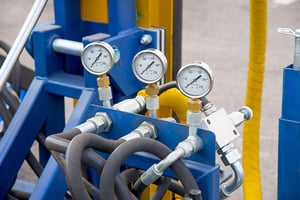 Hydraulics and pneumatics are often grouped together. However, each offers its own distinctive features. When selecting which application to use, it is critical to understand the differences between each system to find the best match. In simple terms, pneumatic systems use the energy collected from air or gas to transmit power. Hydraulics is fluid power that retrieves its power from pressurized liquids.
Hydraulics and pneumatics are often grouped together. However, each offers its own distinctive features. When selecting which application to use, it is critical to understand the differences between each system to find the best match. In simple terms, pneumatic systems use the energy collected from air or gas to transmit power. Hydraulics is fluid power that retrieves its power from pressurized liquids.
Each of these power systems is valuable in particular ways. The main difference between pneumatics and hydraulics is the medium used to produce power. Hydraulics use waters, oils, and other liquid for its power generation. Pneumatics uses air or other gases in its operations to transmit power. These two systems, while very different, do share some common links. They both are relied upon for power for otherwise different practices. Components they both rely upon are cylinders as well as motors to manufacture force. In addition, each requires a pump and valves to function. While mechanisms and functions from hydraulics and pneumatics systems share commonality, they still differ when it comes to the proper uses of each system.
Comparison Pneumatics:
 Pneumatics is a type of power circuit system that is air-operated, which allows it to function at a low pressure. Typically, pneumatics applications utilize pressure around 80 to 100 pounds, while hydraulics range from around 1,000 to 5,000 pounds and in specialized application can amount to over 10,000 psi. Pneumatics can be used in industries where hydraulics can’t, such as food manufacturing, pharmaceutical, and tech and science industries. These are “clean systems” that are safe and free of contamination, unlike a hydraulics system which is preferred in other engineering industries.
Pneumatics is a type of power circuit system that is air-operated, which allows it to function at a low pressure. Typically, pneumatics applications utilize pressure around 80 to 100 pounds, while hydraulics range from around 1,000 to 5,000 pounds and in specialized application can amount to over 10,000 psi. Pneumatics can be used in industries where hydraulics can’t, such as food manufacturing, pharmaceutical, and tech and science industries. These are “clean systems” that are safe and free of contamination, unlike a hydraulics system which is preferred in other engineering industries.
A pneumatics system’s initial cost is less expensive and easier to maintain, which keeps the cost low. In general, the upkeep of a pneumatic system is less complicated to maintain in comparison to a hydraulics system. However, noting the longevity of this type of system, in the long term it may run up a higher operating cost. While its cost efficiencies stand out initially, other areas like safety and cleanness are also vital advantages that are important for certain industries. Since air is an abundant resource, a pneumatic system is able to collect air right from the atmosphere. This isn’t only easier, but also eliminates the risk of air contamination making it both clean and safe.
Comparison Hydraulics
 Hydraulic systems tend to be larger and more complicated than their pneumatic system counterpart. This then brings a benefit to the hydraulic application by assuming heavier loads due to the excess pressure. Hydraulic systems do use a higher force since movement is slower due to larger load handling capabilities. Meanwhile, the opposite holds true for pneumatics where a lower force is used, which then speeds up the motion.
Hydraulic systems tend to be larger and more complicated than their pneumatic system counterpart. This then brings a benefit to the hydraulic application by assuming heavier loads due to the excess pressure. Hydraulic systems do use a higher force since movement is slower due to larger load handling capabilities. Meanwhile, the opposite holds true for pneumatics where a lower force is used, which then speeds up the motion.
Hydraulics systems also contain fewer moving parts, which assists with easier maintenance. In conjunction with simple upkeep, Installation is more complicated, but after that initial investment, the cost is lowered. Another advantage is that the liquids from hydraulics don’t absorb or take away any of the energy that was produced. One of the main differentiating factors around hydraulics is its high precision capabilities. Since these applications use liquids that aren’t compressible, there is no delay, while in pneumatics there is a delay in movement since gas is compressed.
Conclusion
Each of these systems has its advantages and specialties regarding each individual application. Hydraulics are more powerful and meticulous then pneumatic systems, but that doesn’t mean hydraulics is always the optimal choice. Pneumatics aren’t as powerful, but they are cleaner and faster. You often see hydraulics used in more robust industries like construction work, while you mainly see pneumatics in industries like dentistry. Given this, it’s important to understand the processes and limitations of each system when determining which is best suited for an operation. Explore more about hydraulics and pneumatics in this short video.
To learn more about Radwell

